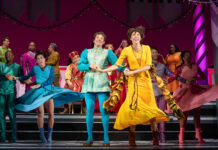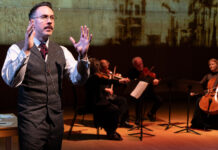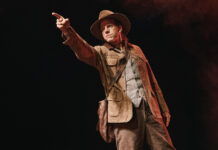When Brad Mehldau takes to the stage at The Theatre at the Ace Hotel, he won’t be performing with his trio, nor will he be going it alone. For this year’s start of the CAP UCLA season, he will be joined by singer and mandolinist Chris Thile. He and Thile will be performing selections from their recent collaboration, Chris Thile & Brad Mehldau.
Mehldau has released 28 albums as a bandleader or soloist since his first recording, Introducing Brad Mehldau, was released in 1995. He’s had multiple recordings under the banner of The Art of the Trio, and has collaborated with such diverse artists as Pat Metheney, Renée Fleming, Joshua Redman and Anne Sofie von Otter.
I recently had a chance, via e-mail, to ask Mr. Mehldau about the nature of collaboration, this particular collaboration and to look back on his career-to-date.
When you are contemplating potential collaborators how do you decide with whom you’d like to record/perform?
It has to be someone who I think will challenge me musically – I don’t want it to be coasting. At the same time, there has to be the sense ahead of time of, “This person and I will find common ground.”
More importantly, how do you know the desired collaboration will yield interesting results? When does the idea of collaboration get surpassed by the realization of that collaboration? Or how do you know it isn’t going to work?
I’ve never had it not work – but that’s just me speaking, others might feel differently. I know some people are not crazy about some of my collaborations, but appreciate them nevertheless taking the time to listen. I think I know ahead of time if it really won’t work. It’s always yielded interesting results for me when I’ve collaborated with other musicians but – is it interesting for the audience? I think it becomes exciting for the audience when they sense that the sum is more than the parts – that something new is happening that could not have been predicted. And frankly, that is also a surprise for me when it happens – if I could plan it, it might be easier, but then it also wouldn’t have the magic.
If you look at some of your collaborators, Anne Sofia von Otter, Pat Metheny, Renée Fleming – what did those experiences have in common, if anything, with your most recent collaboration with Chris Thile?
Common ground. Lots of working out together – with all of them, that meant fantastic conversations about music – about that common ground. Of course the common ground was different with each of them, but not necessarily what you would expect. With Anne Sofie we hooked up on French chanson singers from the 1960’s, Chris and I talked about Bach a lot.
What inspired you most about the possibility of collaborating with Chris Thile prior to your 2013 gigs?
Several things, but at least two: First, I knew from hearing and seeing him that he is a true improviser – and that is what I like to do a lot. Second, his singing really affects me, and I was excited about the idea of making music with that kind of vocal expression.
When you and Chris first performed at the Bowery Ballroom in 2013, you had an eclectic mix of songs in the 90 minute set. How did you select the songs for inclusion on this album and how do they reflect each of your personal and shared sensibilities?
We both like to write, so that’s reflected – there is a good deal of worked out material from both of us, which is always kind of a statement of purpose: “This is me as a composer;” in this case, it’s: “This is me composing for mandolin/piano/voice”, which is less than usual in terms of orchestration. The cover choices reflect those common interests – for interest, a mutual admiration for Elliot Smith.
In the NY Times review of the 2013 gig, Nate Chinen commented that you “rarely entered competitive airspace – an easy trap in this sort of setting as Chick Corea and Béla Fleck might attest.” What are the positive and negative aspects of competition for a musician?
It’s a cliché phrase, but there is a bit of “healthy competition” that works to push you further and not coast on an idea that might more easily come out. You can hear that when we trade back and forth on “Don’t Think Twice…” The negative I guess would be if folks stop listening to each other because of that competitive spirit. I haven’t felt that with Chris.
You are doing a rather limited tour for this project in the US. Why was it important to include Los Angeles as one of the few stops? What does LA mean to you today?
I lived in LA for 5 years, 1995-2000, and enjoyed the whole ride. I was influenced by the music I heard there, particularly at Largo (when it was on Fairfax across from Canter’s): People like Elliot Smith, Rufus Wainwright, Fiona Apple, and last but not least Jon Brion, wno led the troops. It was a fantastic time and place for music and I got in there a bit and it rubbed off on me. Chris also has all of that in his musical DNA. No doubt there’s a bunch of hip new stuff going on in LA that I’m not aware of. Some of my favorite musicians these days live there, like Louis Cole. He is LA for me in the best sense – like Brian Wilson was decades ago. Dreaming, possibility, expanse, right beyond the noise and illusion.
In the movie La La Land, Ryan Gosling’s character laments that jazz is dying and no on cares. Do you agree with that position?
It’s the eternal question. No, and it doesn’t even smell funny, ha ha!
In your Jazz Times Magazine article, “Ideology, Burgers and Beer” you reflect on a word game you played with friends. I’d like to offer a variation of that game for your comment: How would you compare early Brad Mehldau to present day Brad Mehldau? What observations do you have of the direction your music has taken you over the years since “Introducing Brad Mehldau” was released?
Hmmm…early me to present day me. I guess I would take present day – the game there was that you’d have to make a choice, right; you can’t equivocate? But I do notice that other people like my earlier stuff. For me, listening to myself, I perceive that I’ve refined some mannerisms and let go of some affectations that bug me when I listen back to older stuff.













